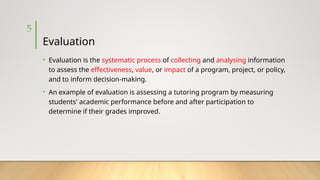Program Evaluation C. I. P. P. Evaluation Model. pptx
- 1. 1 Program Evaluation C. I. P. P. Evaluation Model DR SINDHU ALMAS MBBS, MPH, (MHPE), (PHD) DEPARTMENT OF PUBLIC HEALTH & COMMUNITY MEDICINE LUMHS
- 2. 2 PROGRAM?
- 3. 3 Program ŌĆó "A program is an organized framework of activities and resources designed to achieve specific goals within a target population, addressing identified needs through planned interventions, and incorporating mechanisms for monitoring, evaluation, and improvement to ensure desired outcomes are met.ŌĆØ ŌĆó An example of a program is a community health initiative that provides free vaccinations to children to reduce the incidence of preventable diseases.
- 5. 5 Evaluation ŌĆó Evaluation is the systematic process of collecting and analysing information to assess the effectiveness, value, or impact of a program, project, or policy, and to inform decision-making. ŌĆó An example of evaluation is assessing a tutoring program by measuring students' academic performance before and after participation to determine if their grades improved.
- 6. 6 Models for Curriculumn Evaluation ŌĆó Tyler's Objective-Centred Model ŌĆó Stake's Responsive Evaluation Model ŌĆó Scriven's Goal-Free Evaluation ŌĆó Kirkpatrick's Four Levels of Evaluation ŌĆó The Illuminative Model ŌĆó Bradley's Effectiveness Model ŌĆó StufflebeamŌĆÖs CIPP Model
- 7. I. Introduction to CIPP Model 7
- 8. 8 ŌĆó This model was created by Daniel L. Stufflebeam, a professor at Western Michigan University.
- 9. 9 CIPP Evaluation model ŌĆó C - context ŌĆó I - input ŌĆó P - process ŌĆó P - product approach.
- 10. CIPP Evaluation assisst a decision maker four basic questions 10 What Should we do? Are we doing it is planned? How should we do it? Did the programme worked?
- 11. 11 CIPP Evaluation model ŌĆó The CIPP evaluation model is designed to systematically guide both evaluators and stakeholders in posing relevant questions and conducting assessments at the beginning of a project, while it is in progress, and at its end. ŌĆó This approach seeks to improve and achieve accountability in educational programming through a "learning-by-doing" approach (Zhang et al., 2011).
- 12. 12
- 13. 13
- 14. 14 Context ŌĆó What is the relation of the course to other courses? ŌĆó Is the time adequate? ŌĆó What are critical or important external factors? ŌĆó Should courses be integrated or separate? ŌĆó What are the links between the course and research/extension activities? ŌĆó Is there a need for the course? ŌĆó Is the course relevant to the job needs?
- 15. 15 Input "How should it be done?" ŌĆó Refers to the ingredients of the curriculum which include the goals, instructional strategies, the learners, the teachers, the contents and all the materials needed.
- 16. 16 Input ŌĆó What is the entering ability of students? ŌĆó What are the learning skills of students? ŌĆó What is the motivation of the students? ŌĆó What are the living conditions of students? ŌĆó What is the students' existing knowledge? ŌĆó Are the aims suitable? ŌĆó Do the objectives derive from aim?
- 17. 17 Input ŌĆó Are the objectives 'smart? ŌĆó Is the course content clearly defined? ŌĆó Does the content match student abilities? ŌĆó Is the content relevant to practical problems? ŌĆó What is the theory/practice balance? ŌĆó What resources/equipment are available? ŌĆó What books do the teachers have? ŌĆó What books do the students have
- 18. 18 Input ŌĆó How strong are the teaching strategies of the teachers? ŌĆó What time is available compared with the workload, for preparation? ŌĆó What knowledge, skills and attitudes, related to the subject, do the teachers have? ŌĆó How supportive is the classroom environment? ŌĆó How many students are there? ŌĆó How many teachers are there? ŌĆó How is the course organized? ŌĆó What regulations relate to the training
- 19. 19 Process "Is it being done?" ŌĆó Refers to the ways and means of how the curriculum has been implemented. ŌĆó Monitors the project implementation process. ŌĆó Assess the extent to which participants accept and carry out their roles
- 20. 20 Process ŌĆó What is the workload of the students? ŌĆó How well/actively do students participate? ŌĆó Are there any problems related to teaching? ŌĆó Are there any problems related to learning? ŌĆó Is there an effective 2-way communication? ŌĆó Is knowledge only transferred to students, or do they use and apply it?
- 21. 21 Process ŌĆó Are there any problems which students face in using/applying/analysing the knowledge and skills? ŌĆó Are the teaching and learning process continuously evaluated? ŌĆó Are the teaching and learning affected by practical/institutional problems? ŌĆó What is the level of cooperation/interpersonal relations between teachers and students? ŌĆó How is discipline maintained?
- 22. 22 Product "Did the project succeed?" ŌĆó Indicates if the curriculum accomplishes its goals. ŌĆó Measure, interpret, and judge a project's outcomes by assessing their merit, worth, and significance. ŌĆó Ascertain the extent to which the needs of all the participants were met
- 23. 23 Product ŌĆó Is there one final exam at the end or several during the course? ŌĆó Is there any informal assessment? ŌĆó What is the quality of the assessment? ŌĆó What are the studentsŌĆÖ KSA levels after the course? ŌĆó Is the evaluation carried out for the whole process
- 24. 24 Product ŌĆó How do students use what they learned? ŌĆó How was the overall experience for the teachers and for the students? ŌĆó What are the main 'lessons learned?? ŌĆó Is there an official report? ŌĆó Has the teacher's reputation improved or been ruined as a result
- 25. 25
- 26. 26
- 27. 27 CONCLUSION
- 28. THANKS 28
Editor's Notes
- #23: Knowledge Skills and Abilities



























